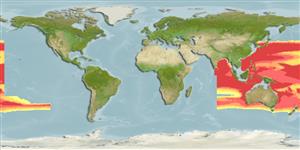Common names from other countries
>
Aulopiformes (Grinners) >
Lestidiidae (Naked barracudinas)
Etymology: Lestrolepis: Greek, lestris, -idos = bandit + Greek,lepis = scale (Ref. 45335).
More on author: Tanaka.
Environment: milieu / climate zone / depth range / distribution range
Ecologie
marien. Subtropical
Western Pacific: widespread; with confirmed records from Japan, Taiwan, the Philippines, nw Australia and the South China Sea.
Grootte / Gewicht / Leeftijd
Maturity: Lm ? range ? - ? cm
Max length : 22.2 cm TL mannelijk / geslacht onbekend; (Ref. 121637); max. gerapporteerde leeftijd: 4 Jaren (Ref. 50621)
Korte beschrijving
Determinatiesleutels | Morfologie | Morfometrie
Dorsale zachte stralen (totaal) : 9; Anale zachte stralen: 36 - 40; Wervels: 82 - 88. This moderately elongate species is distinguished by the following: body depth 13-16 times in SL; dorsal-fin origin clearly before midline of horizontal distance between origins of pelvic (ventral) and anal fins (V-A), origins of pelvic and dorsal fins (V–D) 32.5-43.1% V–A; A 36-40; vertebrae: prehaemal 30-32, prepelvic 30-33, predorsal 36-40, preanal 48-51, caudal 52-58; and total 82-88; total lateral-line scales 66-72; with a narrow band of black chromatophores along lower portion of abdominal ridge (Ref. 121637).
Mesopelagic species (Ref. 7300, 75154). Feeds on small fishes rather than shrimps (Ref. 121637).
Synchronous hermaphrodite (Ref. 84976).
Ho, H.-C., S.-Y. Tsai and H.-H. Li, 2019. The barracudina genera Lestidium and Lestrolepis of Taiwan, with descriptions of two new species (Aulopiformes: Paralepididae). Zootaxa 4702(1):114-139. (Ref. 121637)
Status op de Rode Lijst van het IUCN (Ref. 130435)
CITES (Ref. 128078)
Not Evaluated
Gevaar voor de mens
Harmless
Gebruik door de mens
Tools
Speciale rapporten
Download XML
Internetbronnen
Estimates based on models
Preferred temperature (Ref.
115969): 7.4 - 14.8, mean 9.8 (based on 296 cells).
Fylogenetische diversiteitsindex (Ref.
82804): PD
50 = 0.6250 [Uniqueness, from 0.5 = low to 2.0 = high].
Bayesian length-weight: a=0.00219 (0.00088 - 0.00547), b=3.08 (2.86 - 3.30), in cm Total Length, based on LWR estimates for this (Sub)family-body shape (Ref.
93245).
Trofisch niveau (Ref.
69278): 4.1 ±0.6 se; based on size and trophs of closest relatives
Weerstandsvermogen (Ref.
120179): Gemiddeld, minimale populatieverdubbelingstijd 1,4-4,4 jaar (tm=4; k >0.3; Fec=300-500 (batch fecundity)).
Fishing Vulnerability (Ref.
59153): Low vulnerability (12 of 100).
